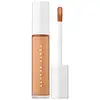Fenty Beauty We're Even Hydrating Longwear Concealer Versus Fenty Beauty Pro Filt'r Instant Retouch Concealer
What's inside
What's inside
 Key Ingredients
Key Ingredients

 Benefits
Benefits

 Concerns
Concerns

 Ingredients Side-by-side
Ingredients Side-by-side

Water
Skin ConditioningCaprylyl Methicone
Skin ConditioningDicaprylyl Carbonate
EmollientUndecane
EmollientPolyglyceryl-2 Dipolyhydroxystearate
Skin ConditioningGlycerin
HumectantPropanediol
SolventTridecane
PerfumingPolyglyceryl-6 Polyricinoleate
EmulsifyingSaccharomyces Ferment
Skin ConditioningAlbizia Julibrissin Bark Extract
MaskingShorea Robusta Resin
TonicSodium Chloride
MaskingPolyglyceryl-3 Diisostearate
Emulsifying1,2-Hexanediol
Skin ConditioningOpuntia Ficus-Indica Stem Extract
Skin ConditioningOctyldodecanol
EmollientStearalkonium Hectorite
Gel FormingDimethicone/Vinyl Dimethicone Crosspolymer
Skin ConditioningTriethoxysilylethyl Polydimethylsiloxyethyl Hexyl Dimethicone
Skin ConditioningDisteardimonium Hectorite
StabilisingPhenoxyethanol
PreservativeTocopheryl Acetate
AntioxidantPropylene Carbonate
SolventLauroyl Lysine
Skin ConditioningSodium Hyaluronate
HumectantSodium Benzoate
MaskingTocopherol
AntioxidantCitric Acid
BufferingSodium Citrate
BufferingIron Oxides
CI 77891
Cosmetic ColorantWater, Caprylyl Methicone, Dicaprylyl Carbonate, Undecane, Polyglyceryl-2 Dipolyhydroxystearate, Glycerin, Propanediol, Tridecane, Polyglyceryl-6 Polyricinoleate, Saccharomyces Ferment, Albizia Julibrissin Bark Extract, Shorea Robusta Resin, Sodium Chloride, Polyglyceryl-3 Diisostearate, 1,2-Hexanediol, Opuntia Ficus-Indica Stem Extract, Octyldodecanol, Stearalkonium Hectorite, Dimethicone/Vinyl Dimethicone Crosspolymer, Triethoxysilylethyl Polydimethylsiloxyethyl Hexyl Dimethicone, Disteardimonium Hectorite, Phenoxyethanol, Tocopheryl Acetate, Propylene Carbonate, Lauroyl Lysine, Sodium Hyaluronate, Sodium Benzoate, Tocopherol, Citric Acid, Sodium Citrate, Iron Oxides, CI 77891
Water
Skin ConditioningHydrogenated Didecene
Skin ConditioningHydrogenated Polyisobutene
EmollientDisteardimonium Hectorite
StabilisingTrimethylsiloxysilicate
EmollientCetyl PEG/PPG-10/1 Dimethicone
EmulsifyingGlycerin
HumectantNylon-12
Dimethicone
EmollientMethicone
EmollientSodium Chloride
MaskingAcrylates/Polytrimethylsiloxymethacrylate Copolymer
Skin ConditioningPolymethylsilsesquioxane
Hydrogenated Styrene/Isoprene Copolymer
Hydroxyacetophenone
AntioxidantLauryl PEG-8 Dimethicone
Hdi/Trimethylol Hexyllactone Crosspolymer
1,2-Hexanediol
Skin ConditioningCaprylyl Glycol
EmollientTocopheryl Acetate
AntioxidantTrisodium Ethylenediamine Disuccinate
Talc
AbrasiveLauroyl Lysine
Skin ConditioningCombretum Fruticosum Flower Nectar
MaskingAlcohol
AntimicrobialButylene Glycol
HumectantPentaerythrityl Tetra-Di-T-Butyl Hydroxyhydrocinnamate
AntioxidantCentella Asiatica Leaf Extract
Skin ConditioningCamellia Sinensis Leaf Extract
AntimicrobialTitanium Dioxide
Cosmetic ColorantIron Oxides
Water, Hydrogenated Didecene, Hydrogenated Polyisobutene, Disteardimonium Hectorite, Trimethylsiloxysilicate, Cetyl PEG/PPG-10/1 Dimethicone, Glycerin, Nylon-12, Dimethicone, Methicone, Sodium Chloride, Acrylates/Polytrimethylsiloxymethacrylate Copolymer, Polymethylsilsesquioxane, Hydrogenated Styrene/Isoprene Copolymer, Hydroxyacetophenone, Lauryl PEG-8 Dimethicone, Hdi/Trimethylol Hexyllactone Crosspolymer, 1,2-Hexanediol, Caprylyl Glycol, Tocopheryl Acetate, Trisodium Ethylenediamine Disuccinate, Talc, Lauroyl Lysine, Combretum Fruticosum Flower Nectar, Alcohol, Butylene Glycol, Pentaerythrityl Tetra-Di-T-Butyl Hydroxyhydrocinnamate, Centella Asiatica Leaf Extract, Camellia Sinensis Leaf Extract, Titanium Dioxide, Iron Oxides
 Reviews
Reviews

Ingredients Explained
These ingredients are found in both products.
Ingredients higher up in an ingredient list are typically present in a larger amount.
1,2-Hexanediol is a synthetic liquid and another multi-functional powerhouse.
It is a:
- Humectant, drawing moisture into the skin
- Emollient, helping to soften skin
- Solvent, dispersing and stabilizing formulas
- Preservative booster, enhancing the antimicrobial activity of other preservatives
Disteardimonium Hectorite comes from the clay mineral named hectorite. It is used to add thickness to a product.
It can also help stabilize a product by helping to disperse other ingredients.
Hectorite is a rare, white clay mineral.
Learn more about Disteardimonium HectoriteGlycerin is already naturally found in your skin. It helps moisturize and protect your skin.
A study from 2016 found glycerin to be more effective as a humectant than AHAs and hyaluronic acid.
As a humectant, it helps the skin stay hydrated by pulling moisture to your skin. The low molecular weight of glycerin allows it to pull moisture into the deeper layers of your skin.
Hydrated skin improves your skin barrier; Your skin barrier helps protect against irritants and bacteria.
Glycerin has also been found to have antimicrobial and antiviral properties. Due to these properties, glycerin is often used in wound and burn treatments.
In cosmetics, glycerin is usually derived from plants such as soybean or palm. However, it can also be sourced from animals, such as tallow or animal fat.
This ingredient is organic, colorless, odorless, and non-toxic.
Glycerin is the name for this ingredient in American English. British English uses Glycerol/Glycerine.
Learn more about GlycerinThis ingredient comes from a fatty acid (lauric acid) and amino acid (lysine). It is used to add a silky feel to cosmetics.
According to a manufacturer, its fatty acid base leaves a silky feeling on the skin. It also has emollient properties because of this. Emollients help soften skin by preventing water from evaporating.
Lauroyl lysine is barely soluble in water.
Learn more about Lauroyl LysineChances are, you eat sodium chloride every day. Sodium Chloride is also known as table salt.
This ingredient has many purposes in skincare: thickener, emulsifier, and exfoliator.
You'll most likely find this ingredient in cleansers where it is used to create a gel-like texture. As an emulsifier, it also prevents ingredients from separating.
There is much debate on whether this ingredient is comedogenic. The short answer - comedogenic ratings don't tell the whole story. Learn more about comegodenic ratings here.
The concensus about this ingredient causing acne seems to be divided. Research is needed to understand if this ingredient does cause acne.
Scrubs may use salt as the primary exfoliating ingredient.
Learn more about Sodium ChlorideTocopheryl Acetate is AKA Vitamin E. It is an antioxidant and protects your skin from free radicals. Free radicals damage the skin by breaking down collagen.
One study found using Tocopheryl Acetate with Vitamin C decreased the number of sunburned cells.
Tocopheryl Acetate is commonly found in both skincare and dietary supplements.
Learn more about Tocopheryl AcetateWater. It's the most common cosmetic ingredient of all. You'll usually see it at the top of ingredient lists, meaning that it makes up the largest part of the product.
So why is it so popular? Water most often acts as a solvent - this means that it helps dissolve other ingredients into the formulation.
You'll also recognize water as that liquid we all need to stay alive. If you see this, drink a glass of water. Stay hydrated!
Learn more about WaterThis ingredient is a combination of red, black, and yellow iron oxide pigments. This combination of colors is usually found in foundation, because it results in a "skin" color.